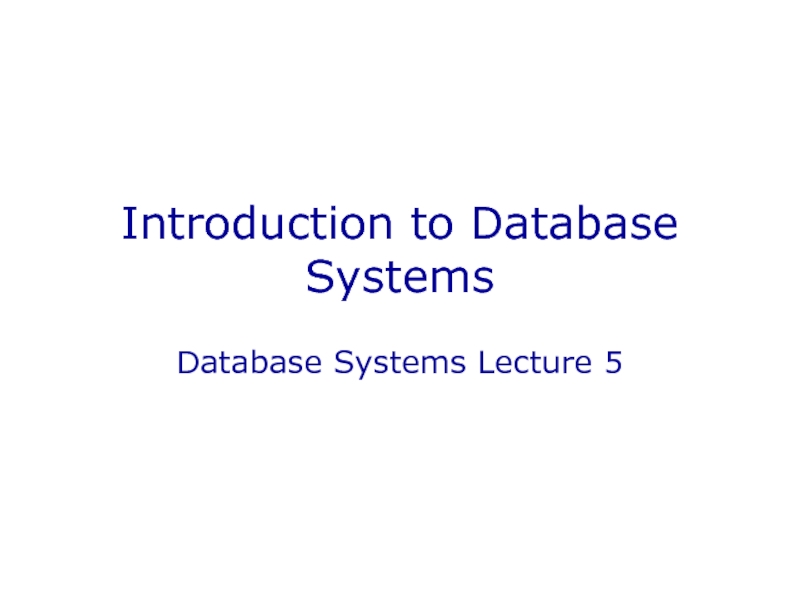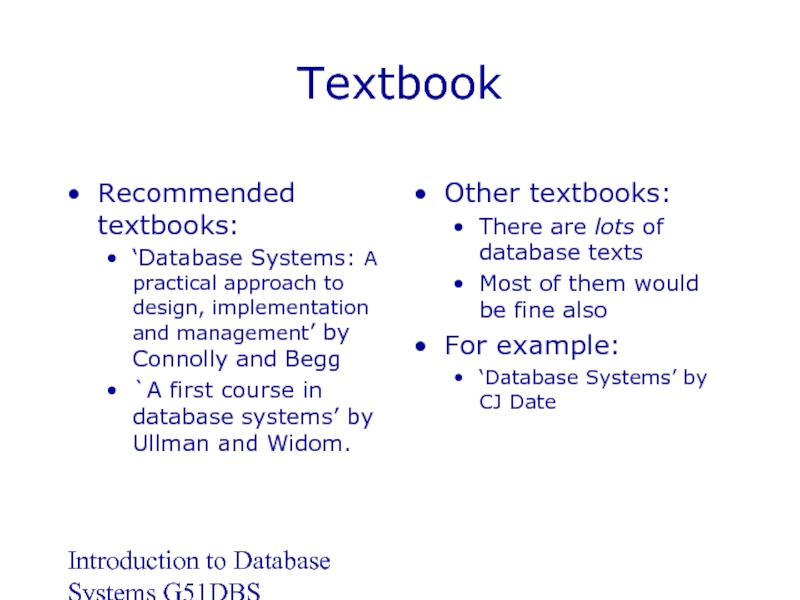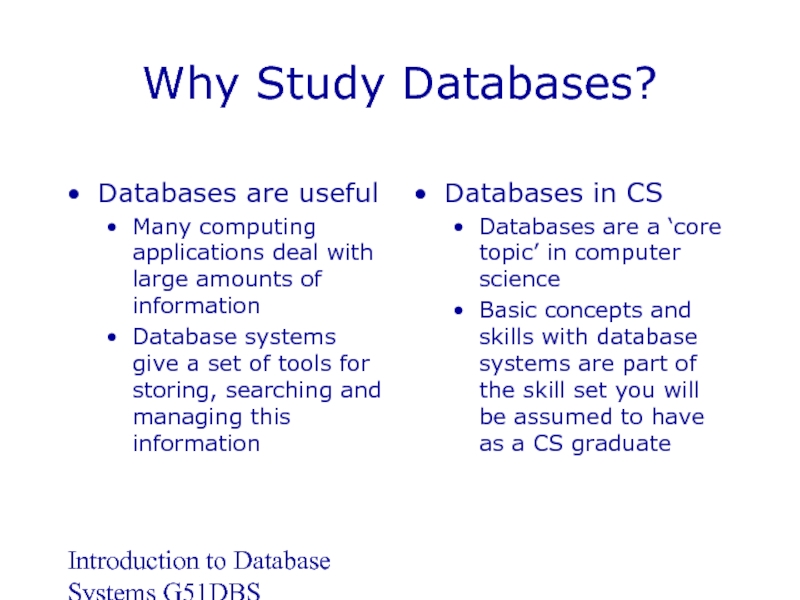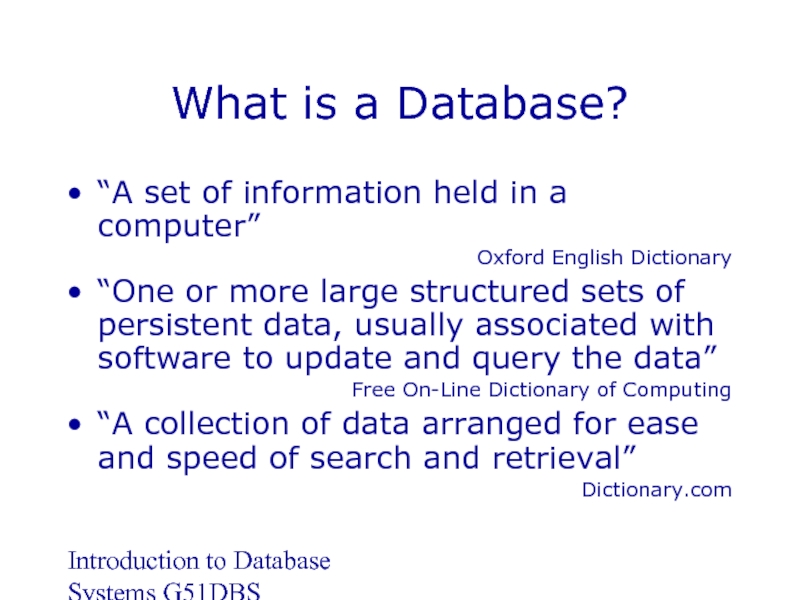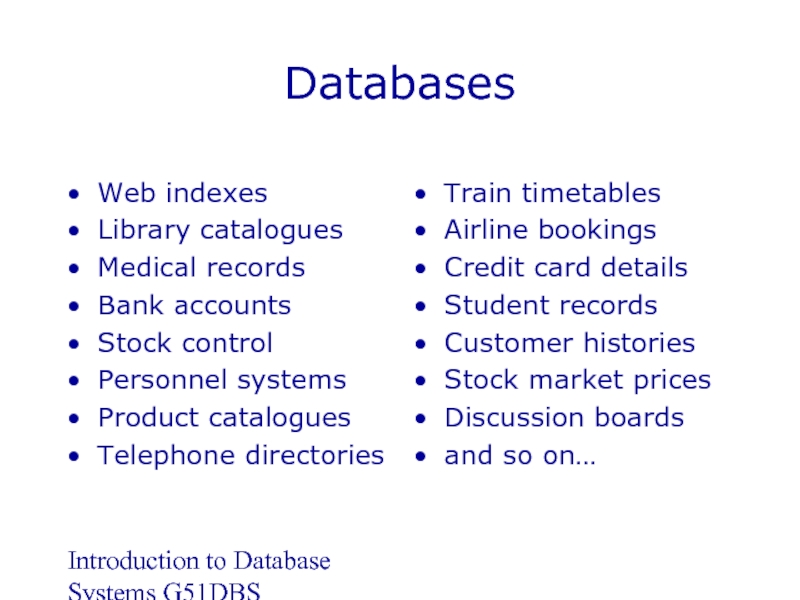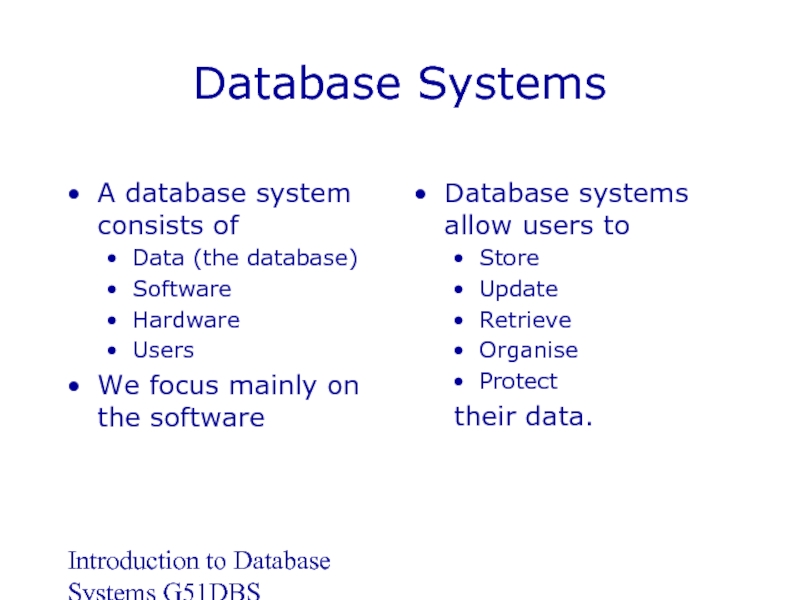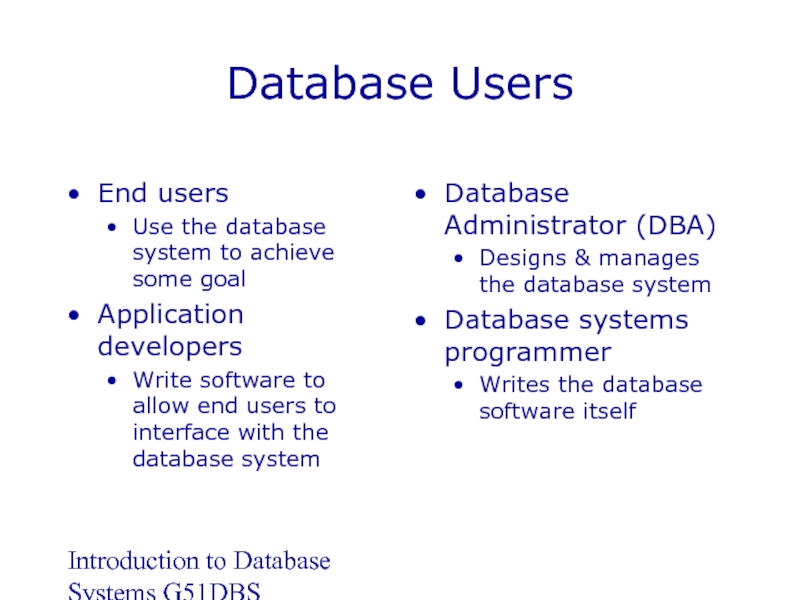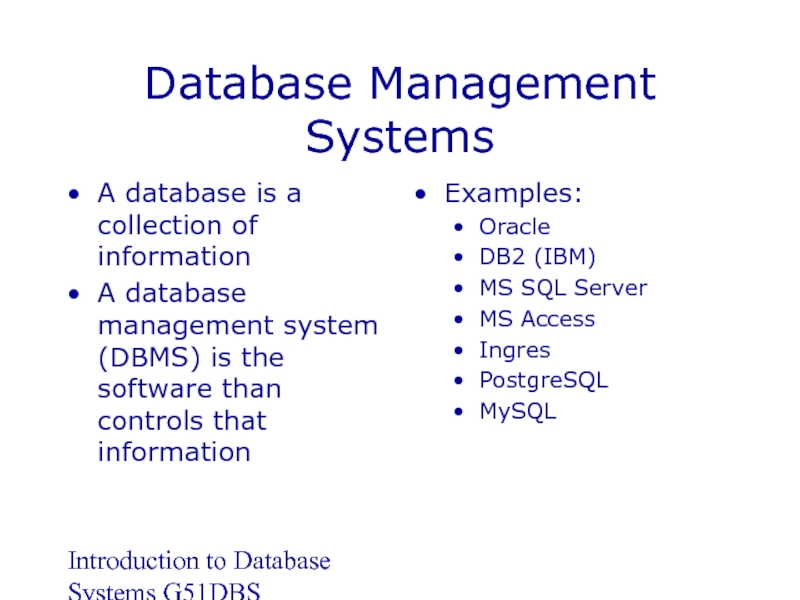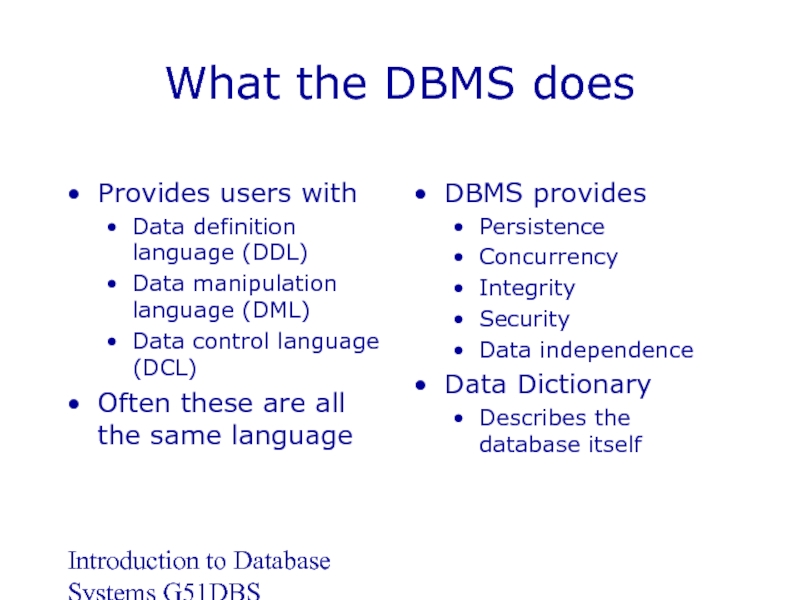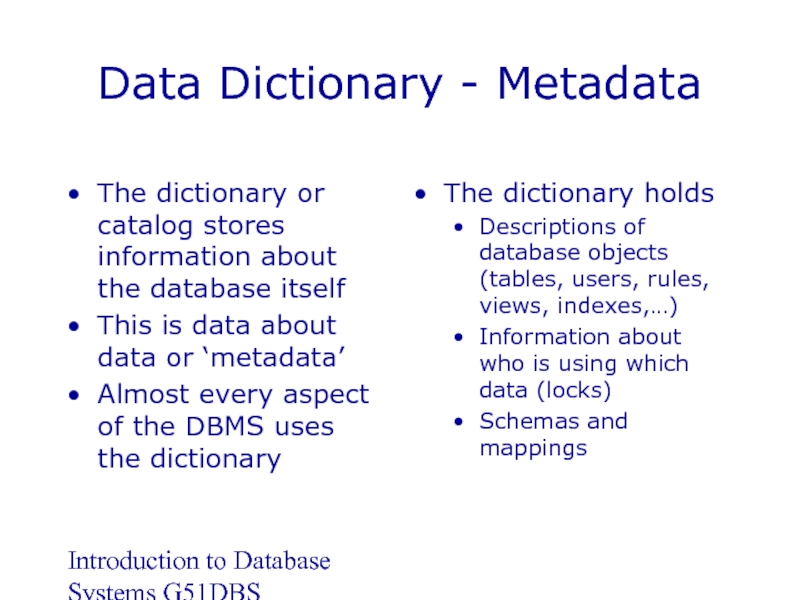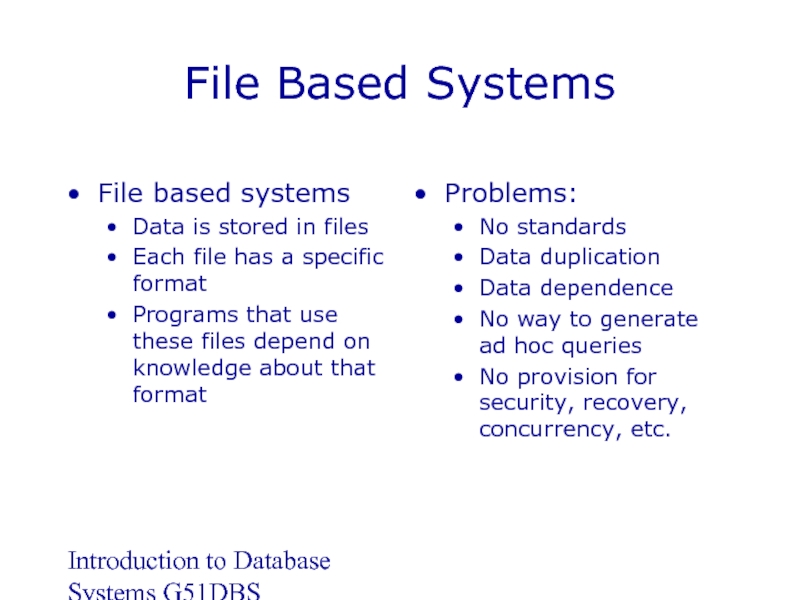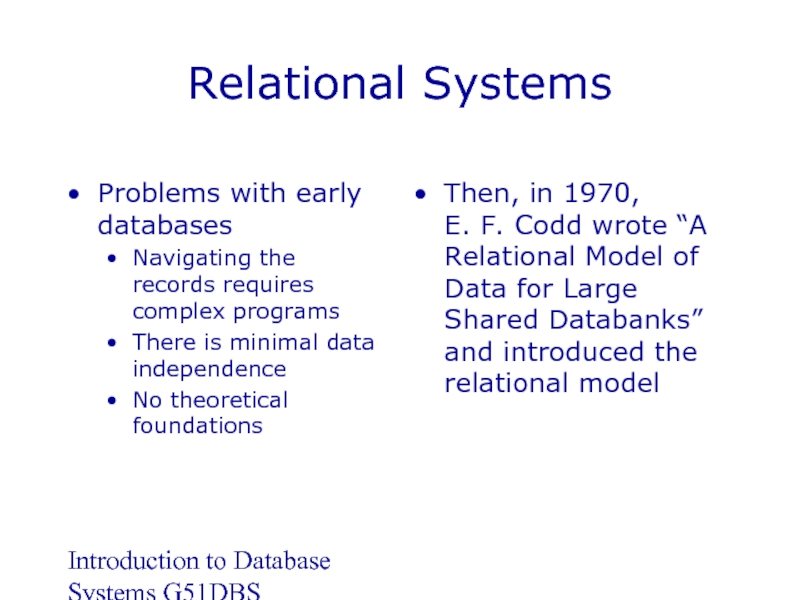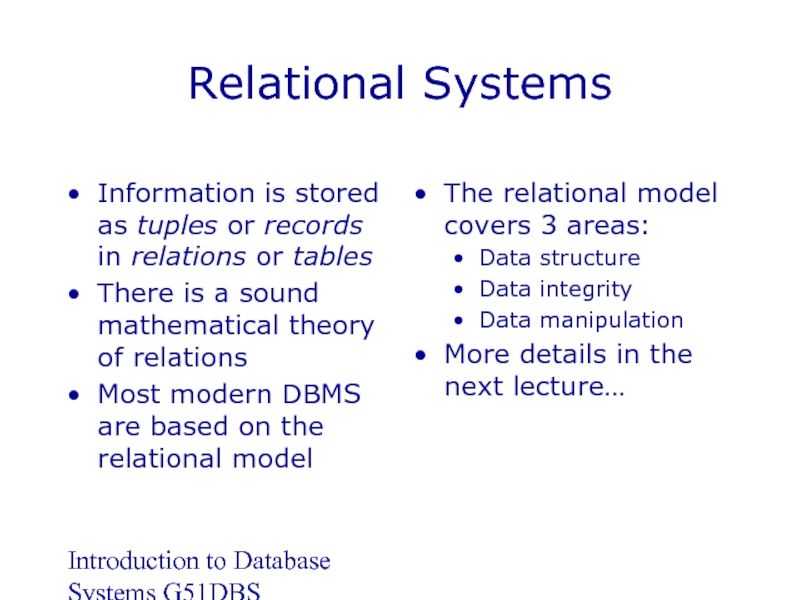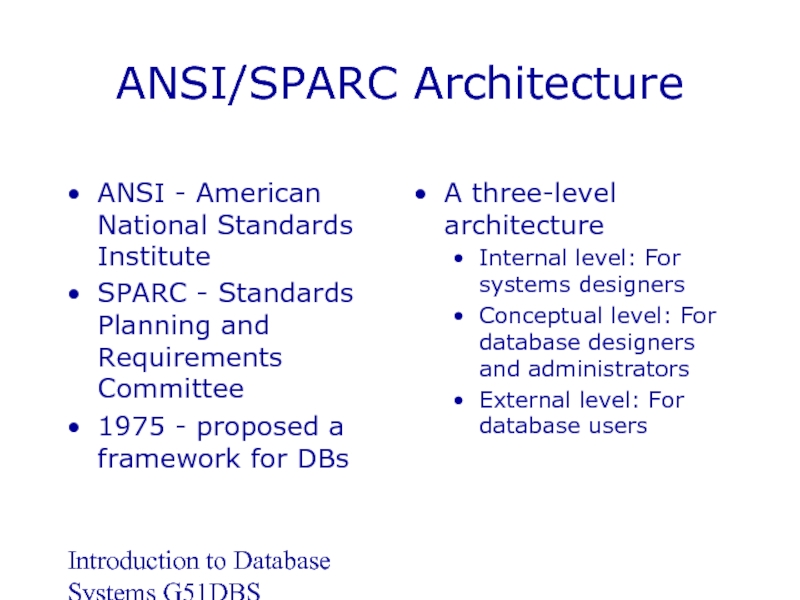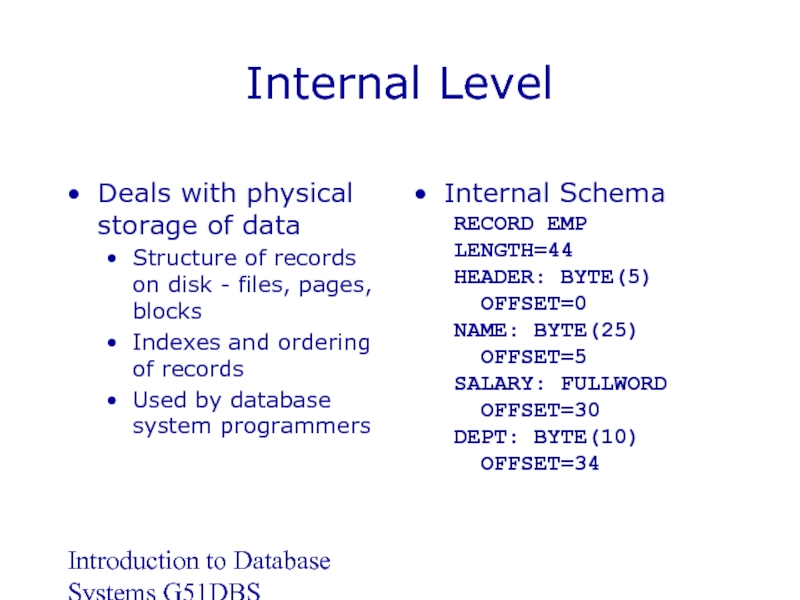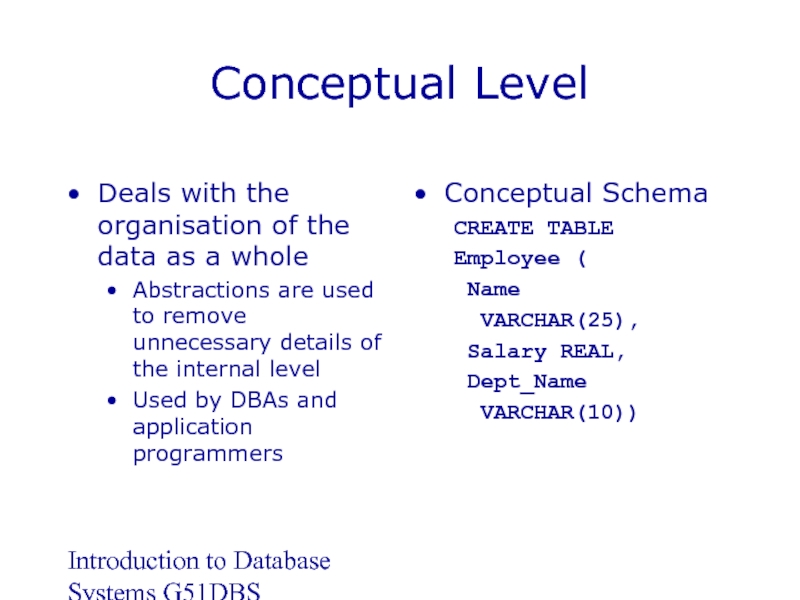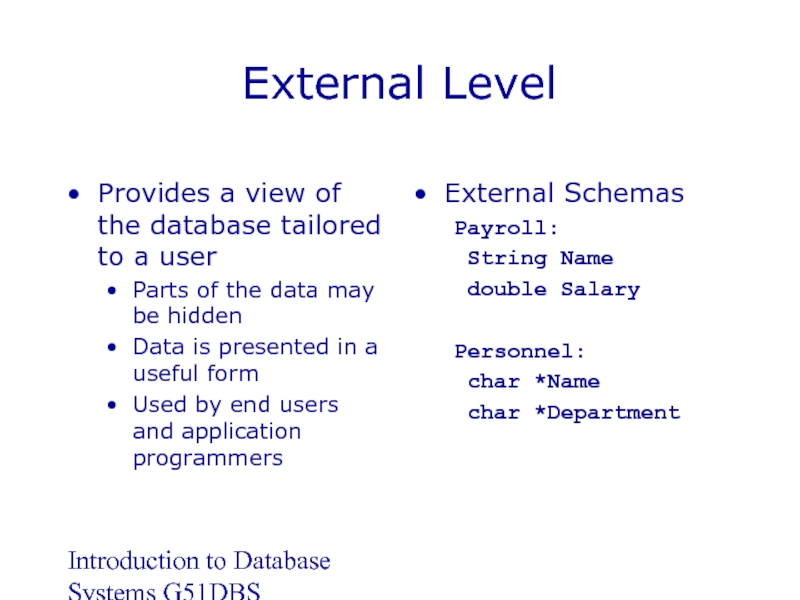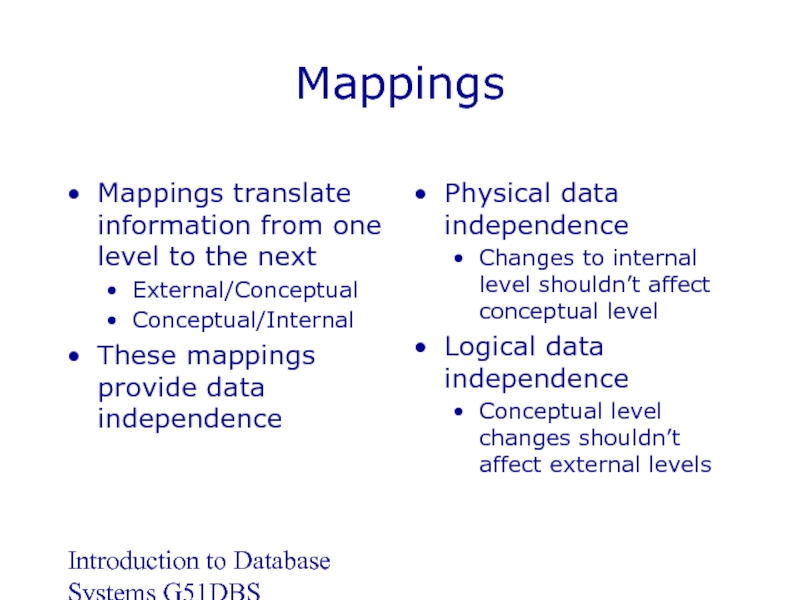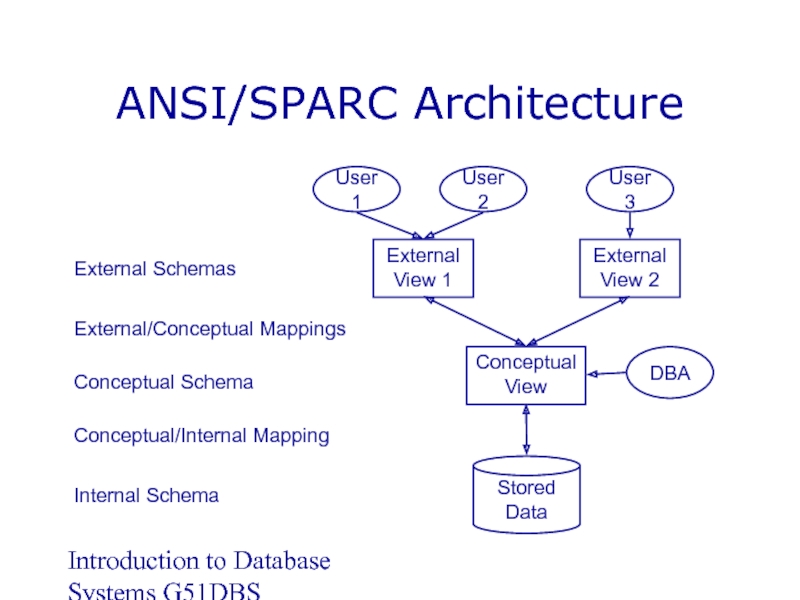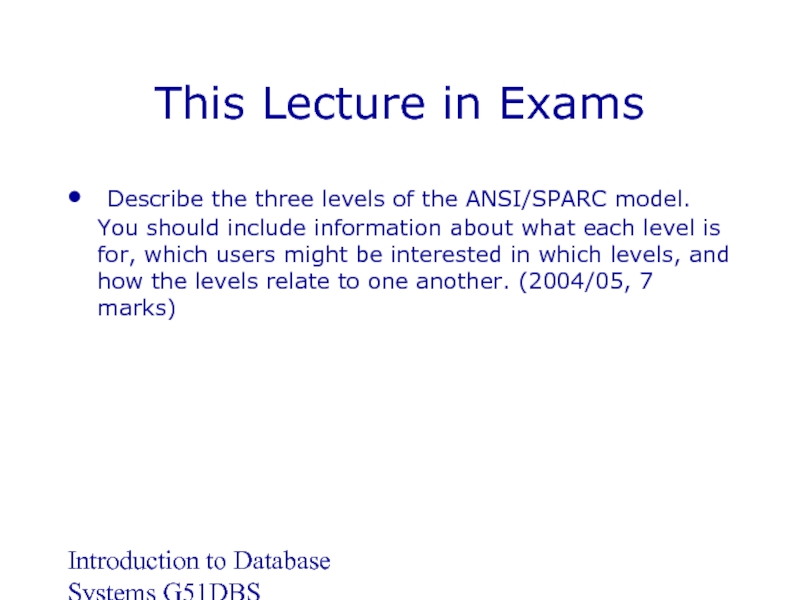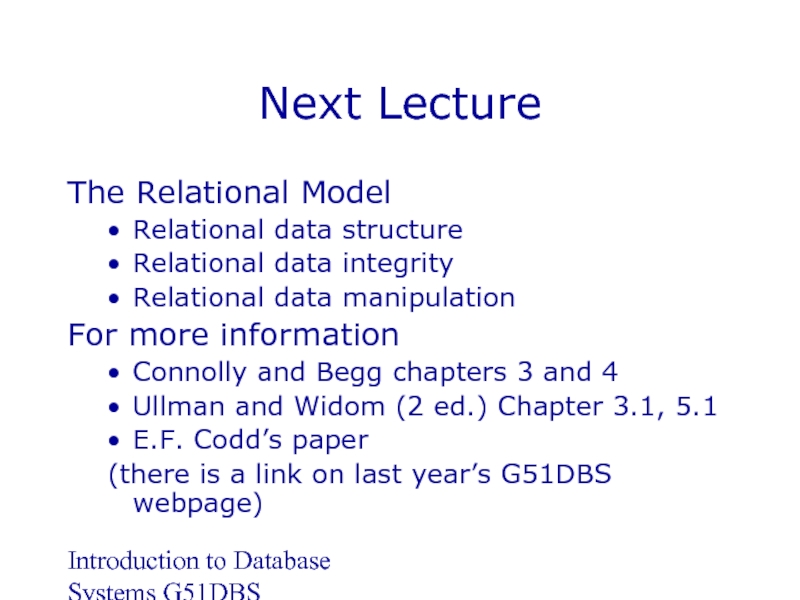- Главная
- Разное
- Дизайн
- Бизнес и предпринимательство
- Аналитика
- Образование
- Развлечения
- Красота и здоровье
- Финансы
- Государство
- Путешествия
- Спорт
- Недвижимость
- Армия
- Графика
- Культурология
- Еда и кулинария
- Лингвистика
- Английский язык
- Астрономия
- Алгебра
- Биология
- География
- Детские презентации
- Информатика
- История
- Литература
- Маркетинг
- Математика
- Медицина
- Менеджмент
- Музыка
- МХК
- Немецкий язык
- ОБЖ
- Обществознание
- Окружающий мир
- Педагогика
- Русский язык
- Технология
- Физика
- Философия
- Химия
- Шаблоны, картинки для презентаций
- Экология
- Экономика
- Юриспруденция
Introduction to Database Systems презентация
Содержание
- 1. Introduction to Database Systems
- 2. Introduction to Database Systems G51DBS Textbook Recommended
- 3. Introduction to Database Systems G51DBS Why Study
- 4. Introduction to Database Systems G51DBS What is
- 5. Introduction to Database Systems G51DBS Databases Web
- 6. Introduction to Database Systems G51DBS Database Systems
- 7. Introduction to Database Systems G51DBS Database Users
- 8. Introduction to Database Systems G51DBS Database Management
- 9. Introduction to Database Systems G51DBS What the
- 10. Introduction to Database Systems G51DBS Data Dictionary
- 11. Introduction to Database Systems G51DBS File Based
- 12. Introduction to Database Systems G51DBS Relational Systems
- 13. Introduction to Database Systems G51DBS Relational Systems
- 14. Introduction to Database Systems G51DBS ANSI/SPARC Architecture
- 15. Introduction to Database Systems G51DBS Internal Level
- 16. Introduction to Database Systems G51DBS Conceptual Level
- 17. Introduction to Database Systems G51DBS External Level
- 18. Introduction to Database Systems G51DBS Mappings Mappings
- 19. Introduction to Database Systems G51DBS ANSI/SPARC Architecture
- 20. Introduction to Database Systems G51DBS This Lecture
- 21. Introduction to Database Systems G51DBS Next Lecture
Слайд 2Introduction to Database Systems G51DBS
Textbook
Recommended textbooks:
‘Database Systems: A practical approach to
`A first course in database systems’ by Ullman and Widom.
Other textbooks:
There are lots of database texts
Most of them would be fine also
For example:
‘Database Systems’ by CJ Date
Слайд 3Introduction to Database Systems G51DBS
Why Study Databases?
Databases are useful
Many computing applications
Database systems give a set of tools for storing, searching and managing this information
Databases in CS
Databases are a ‘core topic’ in computer science
Basic concepts and skills with database systems are part of the skill set you will be assumed to have as a CS graduate
Слайд 4Introduction to Database Systems G51DBS
What is a Database?
“A set of information
Oxford English Dictionary
“One or more large structured sets of persistent data, usually associated with software to update and query the data”
Free On-Line Dictionary of Computing
“A collection of data arranged for ease and speed of search and retrieval”
Dictionary.com
Слайд 5Introduction to Database Systems G51DBS
Databases
Web indexes
Library catalogues
Medical records
Bank accounts
Stock control
Personnel systems
Product
Telephone directories
Train timetables
Airline bookings
Credit card details
Student records
Customer histories
Stock market prices
Discussion boards
and so on…
Слайд 6Introduction to Database Systems G51DBS
Database Systems
A database system consists of
Data (the
Software
Hardware
Users
We focus mainly on the software
Database systems allow users to
Store
Update
Retrieve
Organise
Protect
their data.
Слайд 7Introduction to Database Systems G51DBS
Database Users
End users
Use the database system
Application developers
Write software to allow end users to interface with the database system
Database Administrator (DBA)
Designs & manages the database system
Database systems programmer
Writes the database software itself
Слайд 8Introduction to Database Systems G51DBS
Database Management Systems
A database is a collection
A database management system (DBMS) is the software than controls that information
Examples:
Oracle
DB2 (IBM)
MS SQL Server
MS Access
Ingres
PostgreSQL
MySQL
Слайд 9Introduction to Database Systems G51DBS
What the DBMS does
Provides users with
Data definition
Data manipulation language (DML)
Data control language (DCL)
Often these are all the same language
DBMS provides
Persistence
Concurrency
Integrity
Security
Data independence
Data Dictionary
Describes the database itself
Слайд 10Introduction to Database Systems G51DBS
Data Dictionary - Metadata
The dictionary or catalog
This is data about data or ‘metadata’
Almost every aspect of the DBMS uses the dictionary
The dictionary holds
Descriptions of database objects (tables, users, rules, views, indexes,…)
Information about who is using which data (locks)
Schemas and mappings
Слайд 11Introduction to Database Systems G51DBS
File Based Systems
File based systems
Data is stored
Each file has a specific format
Programs that use these files depend on knowledge about that format
Problems:
No standards
Data duplication
Data dependence
No way to generate ad hoc queries
No provision for security, recovery, concurrency, etc.
Слайд 12Introduction to Database Systems G51DBS
Relational Systems
Problems with early databases
Navigating the records
There is minimal data independence
No theoretical foundations
Then, in 1970, E. F. Codd wrote “A Relational Model of Data for Large Shared Databanks” and introduced the relational model
Слайд 13Introduction to Database Systems G51DBS
Relational Systems
Information is stored as tuples or
There is a sound mathematical theory of relations
Most modern DBMS are based on the relational model
The relational model covers 3 areas:
Data structure
Data integrity
Data manipulation
More details in the next lecture…
Слайд 14Introduction to Database Systems G51DBS
ANSI/SPARC Architecture
ANSI - American National Standards Institute
SPARC
1975 - proposed a framework for DBs
A three-level architecture
Internal level: For systems designers
Conceptual level: For database designers and administrators
External level: For database users
Слайд 15Introduction to Database Systems G51DBS
Internal Level
Deals with physical storage of data
Structure
Indexes and ordering of records
Used by database system programmers
Internal Schema
RECORD EMP
LENGTH=44
HEADER: BYTE(5)
OFFSET=0
NAME: BYTE(25)
OFFSET=5
SALARY: FULLWORD
OFFSET=30
DEPT: BYTE(10)
OFFSET=34
Слайд 16Introduction to Database Systems G51DBS
Conceptual Level
Deals with the organisation of the
Abstractions are used to remove unnecessary details of the internal level
Used by DBAs and application programmers
Conceptual Schema
CREATE TABLE
Employee (
Name
VARCHAR(25),
Salary REAL,
Dept_Name
VARCHAR(10))
Слайд 17Introduction to Database Systems G51DBS
External Level
Provides a view of the database
Parts of the data may be hidden
Data is presented in a useful form
Used by end users and application programmers
External Schemas
Payroll:
String Name
double Salary
Personnel:
char *Name
char *Department
Слайд 18Introduction to Database Systems G51DBS
Mappings
Mappings translate information from one level to
External/Conceptual
Conceptual/Internal
These mappings provide data independence
Physical data independence
Changes to internal level shouldn’t affect conceptual level
Logical data independence
Conceptual level changes shouldn’t affect external levels
Слайд 19Introduction to Database Systems G51DBS
ANSI/SPARC Architecture
External Schemas
External/Conceptual Mappings
Conceptual Schema
Internal Schema
Conceptual/Internal Mapping
Слайд 20Introduction to Database Systems G51DBS
This Lecture in Exams
Describe the three levels
Слайд 21Introduction to Database Systems G51DBS
Next Lecture
The Relational Model
Relational data structure
Relational data
Relational data manipulation
For more information
Connolly and Begg chapters 3 and 4
Ullman and Widom (2 ed.) Chapter 3.1, 5.1
E.F. Codd’s paper
(there is a link on last year’s G51DBS webpage)
